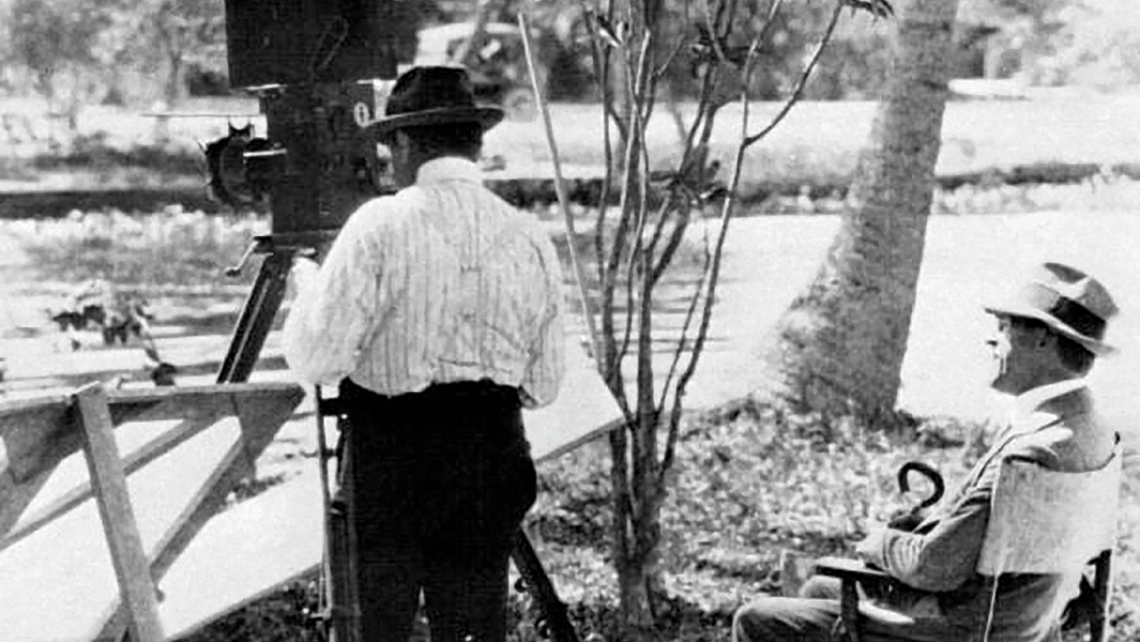
You’ve probably seen some of the films shot in Fort Lauderdale – There’s Something About Mary, Out of Sight, Cape Fear, Donnie Brasco – maybe even Where the Boys Are.
But those were latecomers to the party. It was legendary director D.W. Griffith who made the first big-time Hollywood film here – in 1919. The population was less than 2,000, including a couple dozen registered Seminoles.
Builders of the first major hotel, rushing to get ready before the production company arrived, hadn’t quite finished. No problem for director Griffith: He had the company’s set people help finish carpentry and room decoration.
A dining area was not yet complete either. No matter again: Griffith’s traveling production kitchen cooked meals. That residence was the Broward Hotel, now long gone.
The film was The Idol Dancer, about romance and intrigue on a South Seas island. So why come here?
According to historian Stuart McIver, Griffith told locals then: “You people who live here and pursue your daily occupation amidst the natural tropical beauty of the country probably do not realize how wonderful your country is. But to someone who has never seen it before it is a revelation. There may be more beautiful rivers in the world than the New River, which flows through the heart of your city, but if so I have never seen it.”
The Idol Dancer – still in the silent film era – was the first to open in theaters, but Griffith was also shooting South Seas-style settings for a second drama, The Love Flower.
Griffith was a giant in the movie industry’s early years, inventing many of the cinematic techniques (close-ups, for example) still used today. He made an astounding 500 films between 1915 and 1931. During the year he was shooting here, he founded United Artists together with Charlie Chaplin, Mary Pickford and Douglas Fairbanks. Chaplin called Griffith “the teacher of us all.”
Filmmakers from Alfred Hitchcock to Stanley Kubrick praised Intolerance, Griffith’s second major film, which had four parallel story lines that were centuries apart. His first, 1915’s Birth of a Nation, was also a blockbuster, lauded for its pioneering cinematic and narrative techniques, but criticized for its nonjudgmental portrayal of slavery and the Ku Klux Klan. (Spike Lee’s latest film, BlacKkKlansman, features disturbing clips from Birth of a Nation.)
Griffith as director also had run-ins with Hollywood bigwigs. That prompted this from Orson Welles, a legend himself: “I have never really hated Hollywood except for its treatment of D. W. Griffith. No town, no industry, no profession, no art form owes so much to a single man.”
Set on a South Seas island, The Idol Dancer is the story of a young woman who loves to dance. The daughter of a French father and a Javanese mother, she has two suitors. One is a beachcomber and ne’er-do-well tossed off a passing ship, the second an infirm young American living on the island to regain his health. At some point natives from another island attack. The beachcomber reforms, and Mary comes to love him.
Of course, the whole town came out to watch filming. While the stars were from Hollywood (Richard Barthelmess and Clarine Seymour), locals got parts in the film. Marion Reed, the daughter of former mayor Captain Will Reed, was in it, as well as Seminole interpreter Tony Tommie, who recruited additional Seminoles as actors. Even local schoolgirls were extras in a wedding scene.
Since there were no bridges built yet, boat captains ferried actors and crew back and forth across the New River; island village sets had been created on local farmland.
And when all the shooting was done, Griffith threw a Thanksgiving dance for the whole town.
Released in 1920, neither The Idol Dancer nor The Love Flower turned out to be critically acclaimed movies; they are barely mentioned by film historians. And in 1927, “talkies” came along, as The Jazz Singer hastened the end of the silent film era.
But for bringing Hollywood moviemaking to town, D.W. Griffith certainly earned rave reviews from our fledgling settlement.











